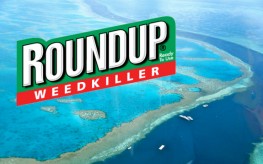Monsanto’s RoundUp (Glyphosate) Threatens Ocean Life, Coral Reefs


As if we need more evidence that glyphosate, the active ingredient in Monsanto’s flagship weed-killer, is dangerous to both people and the environment, a new study suggests it could be at least partially to blame for the declining coral reefs around the world.
According to GreenMedInfo, the Great Barrier Reef is “the world’s biggest single structure made by living organisms. It can even be seen from space. But, since 1985, the reef has lost more than half its coral cover—more than half! Scientists blame the degradation of the Great Barrier Reef and other coral reefs on a variety of causes including climate change, increased predator species, and pollution. But a new study published in Marine Pollution Bulletin indicates glyphosate may need to be added to the list.
”Glyphosate persistence in seawater” looks at the impact of the agro-chemical on sea life. The researchers found that glyphosate is particularly persistent and dangerous in sea water. It’s half-life, or the rate at which it breaks down, is dramatically longer in the ocean.
The study says, “the half-life for glyphosate at 25°C in low-light was 47 days, extending to 267 days in the dark at 25°C and 315 days in the dark at 31°C, which is the longest persistence reported for this herbicide.” But, in the soil, the chemical’s half-life is as quick as 5 days; in bog or fresh water, it’s 49 days.
Read: Herbicide Chemical Glyphosate Triggers Cancer-Causing Fungi
The study abstract reads:
“Glyphosate is one of the most widely applied herbicides globally but its persistence in seawater has not been reported…AMPA, the microbial transformation product of glyphosate, was detected under all conditions, confirming that degradation was mediated by the native microbial community. This study demonstrates glyphosate is moderately persistent in the marine water under low light conditions and is highly persistent in the dark. Little degradation would be expected during flood plumes in the tropics, which could potentially deliver dissolved and sediment-bound glyphosate far from shore.”
Coral reefs are largely plant life. Glyphosate is a plant-killer, designed to annihilate any life it contacts that isn’t protected by genetic modification. If glyphosate is surviving weeks and months in the sea after it runs off from nearby agriculture, officials better pay attention.
Australia uses Roundup at a rate of 30 million pounds each year (though not quite comparable to the 180-185+ million pounds used in the U.S. each year). Most of this ends up finding its way to the ocean. From November to March in the wet season, you can see plumes of run-off entering the sea, carrying sediment, nutrients, and pesticides as far as 50km offshore.
To suggest Monsanto’s Roundup and glyphosate are part of these plumes is not some radical idea—it’s not only possible, it’s probable. And with this coral reef and others dying off at an alarming rate, something needs to be done.

The article says nothing about glyphosate being harmful to coral reefs. Lrn2science.
true, the warming of the ocean and hurricanes damage coral reefs and so does the illegal use of cyanide to stun and catch tropical fish that are sold in pet stores.
You keep spreading this mis-information Alan. Molecules “about the same size” are still not “the same size”.Distillation DOES remove all of the fluoride from your tap water.
One must remember that there are many chemicals that are found in water that will distill at a lower temperature than water. So you are no always sure what ratio you will get with distilling.
In the ocean any glyphosate will be be infinitely diluted. This means it will have no effect whatosever.
The ‘flouride’ in water is sodium monofluoroPHOSPHATE. This is a totally different chemical to sodium monofluoroACETATE (1080) used in rat poison.
Virtually every beverage manufacturer and bottled water company removes the fluoride from water. it is a very simple process using reverse osmosis.
Volcanoes add VASTLY more fluorine to the environment than humans.
High levels of NATURAL occurring fluoride is found groundwater in many parts of the world.